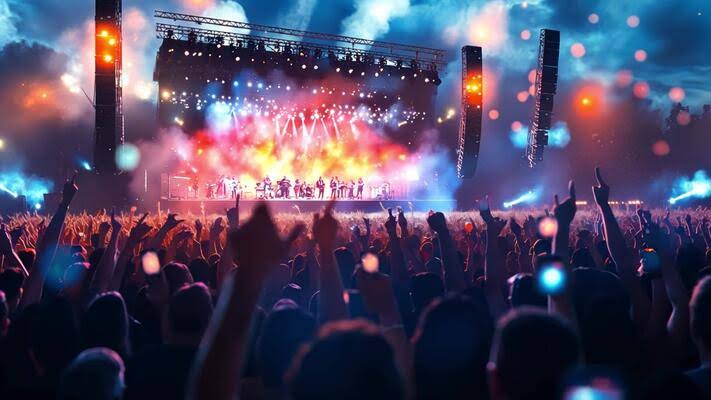Led Zeppelin were known for their explosive live shows, with massive stacks of Marshall amplifiers. They created an ear-splitting onslaught of sound that left a lasting impact. Led Zeppelin were well-known for playing extended versions of their songs
– all at an unbelievably loud volume.
In 1969, they played a rollicking rendition of Heartbreaker that’s said to have reached 130 decibels. 130 dB is the equivalent of standing right behind a…..
Sure! Here’s an 800-word news-style article that captures the intensity of Led Zeppelin’s legendary live shows, especially focusing on their outrageous volume and extended performances:
BREAKING: The Loudest Legends – Led Zeppelin’s Explosive Live Shows Redefined Rock and Shattered Sound Barriers
April 21, 2025 – Long before pyrotechnics, synchronized light shows, and computerized sound systems became the standard in arena rock, one band laid the foundation with nothing more than raw talent, towering amps, and an ear-splitting wall of sound. That band was Led Zeppelin, and their live performances in the late 1960s and 1970s weren’t just concerts—they were sonic earthquakes.
Known for massive stacks of Marshall amplifiers, extended jam sessions, and the sheer force of their sound, Led Zeppelin’s live shows pushed the boundaries of what music could physically and emotionally do to an audience. Their concerts didn’t just leave fans with memories—they left them with ringing ears and awe-struck silence.
Led Zeppelin weren’t just loud—they were legendary for it.
The sheer volume of their shows became almost mythical. In 1969, during a performance of “Heartbreaker,” it’s said the band reached an ear-shattering 130 decibels—a sound pressure level equivalent to standing right behind a jet engine on takeoff. To put it in perspective, OSHA today recommends hearing protection for anything over 85 dB. Zeppelin were playing at nearly 50% louder than that threshold.
“We didn’t set out to be loud just for the sake of it,” said guitarist Jimmy Page in a later interview. “But when you’re playing with that much energy, and Bonzo [John Bonham] is pounding like thunder, you need the sound to match the fury.”
The fury was very real. John Bonham’s drumming was a force of nature—relentless, pounding, and precise. He could outpower a wall of guitar amps with a single bass drum hit. With Bonham behind the kit, Robert Plant howling like a banshee, John Paul Jones grounding the madness with bass and keys, and Page’s Les Paul screaming through Marshalls turned to 11, Zeppelin created an onslaught of sound that changed the live music landscape forever.
Unlike many of their contemporaries, Led Zeppelin didn’t rely on radio-friendly setlists or quick, predictable performances. Instead, they delivered epic, improvised versions of their songs. A studio track like “Dazed and Confused” might run 6 minutes on vinyl, but live it could stretch beyond 25 minutes, complete with bowed guitar solos, eerie echo effects, and hard-hitting crescendos that took the audience on a psychedelic trip.
And they did it all at maximum volume.
Venues struggled to handle it. Microphones couldn’t always withstand the force. Engineers were constantly tweaking levels to avoid blowing the PA systems—still primitive in the early ‘70s—while the band insisted on pushing them to their absolute limits.
The equipment itself became part of the legend. Page’s Marshall Super Lead stacks, Bonham’s oversized Ludwig drums, Plant’s stacked vocal monitors, and Jones’ elaborate keyboard rigs helped turn Led Zeppelin’s shows into a full-blown spectacle. The sheer physicality of the gear—stacked to the ceiling, glowing hot, and buzzing with electricity—made each performance feel like a battle between man, machine, and music.
One of the most famous examples came during a 1970 concert at London’s Royal Albert Hall, where the power of their performance reportedly caused pieces of the ceiling to fall, and a significant portion of the crowd to retreat toward the back for relief from the intensity.
But perhaps the most astonishing part of Led Zeppelin’s live dominance was the discipline behind the chaos. For all their improvisation, Zeppelin’s musicianship was razor-sharp. They could stop and start on a dime, shift tempo mid-song, or launch into unreleased material with ease. Their concerts were controlled storms—massive, unpredictable, and yet fully within their command.
As their popularity grew, so did the scale of their shows. By 1973, Zeppelin were filling massive arenas like Madison Square Garden, where they famously performed multiple sold-out shows captured in the concert film The Song Remains the Same. By 1977, they were headlining stadiums across the U.S., bringing their massive sound to over 70,000 fans at a time.
Critics didn’t always know what to make of it. Some dismissed the volume and grandeur as excessive. Others called it revolutionary. But fans knew: no one sounded like Led Zeppelin live.
Even today, their influence is everywhere. Modern bands continue to chase their tone, volume, and unrelenting energy. From Foo Fighters to Greta Van Fleet, the DNA of Zeppelin’s live experience lives on.
And yet, for those lucky enough to have witnessed it firsthand, the original still reigns supreme.
“They weren’t just loud,” recalls one concertgoer who saw Zeppelin in 1971. “They were transcendent. You didn’t just hear the music—you felt it in your bones. It was like being swallowed by the sound.”
As we celebrate the legacy of live music titans in 2025, Led Zeppelin still stands tall among them—the thunder that shook the world, leaving a trail of melted faces, ringing ears, and rock history written in the language of volume.

